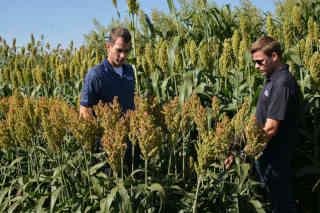By Kay Ledbetter
With dairy cattle numbers increasing in Texas, especially over the Ogallala Aquifer where water resources are limited, producers and researchers are seeking drought-tolerant, quality forages to meet the demand for cattle feed.

Texas A&M AgriLife Extension Service dairy specialist Juan Piñeiro, Ph.D., DVM, and graduate student Douglas Duhatschek, both in Amarillo, have spent the past two years trying to determine how sorghum can fill that demand.
Corn silage historically has been the silage of choice, but corn requires more water than sorghum. On the flip side, sorghum produces less metabolizable energy than corn. And nutrition, or energy, is the biggest concern for lactating dairy cows.
Piñeiro and Duhatschek’s latest research indicates the high sugar content in male-sterile sorghum hybrids may offer a big opportunity to produce water-efficient forage with highly digestible fiber and good energy content.
The research projects are being funded in part by United Sorghum Checkoff Program, Dairy Management Inc. and Richardson Seed Co.
In the sorghum research fields
The starch in whole-plant forage sorghum silage is less digestible than the starch in corn silage because sorghum berries do not break down enough in processing to allow for maximum digestibility.
“We initially evaluated the starch digestibility of forage sorghum by growing hybrids with a larger berry size to see if that might be better processed and increase the starch digestibility,” Piñeiro said. “However, that study did not show any improvement in starch digestibility, so we tried a different approach in 2022.”
The team conducted two studies in 2022. In one study, the researchers worked with shorter plants that had proportionally more grain than leaves and stems. They wanted to see if the increase in the reproductive-to-vegetative plant parts ratio would increase the overall starch digestibility.
The second study utilized two male-sterile hybrids that do not develop grain: a brown midrib, BMR, hybrid and a non-BMR hybrid.
“We focused on forage digestibility and noticed that since these hybrids do not develop grain, the content of sugars at harvest is four to five times higher than with other sorghums that develop grain,” Piñeiro said. “For these male-sterile hybrids, we only have some preliminary results, but they look promising.”
He said the fiber digestibility of BMR hybrids is similar to that of conventional corn silage. In addition, both BMR and non-BMR male-sterile hybrids store high sugar content because they do not develop grain and also store much less starch. These plant sugars could partially replace the energy loss due to low starch concentration.
“We know fiber digestibility of most BMR sorghum hybrids can be as good as conventional corn hybrids from previous research,” Piñeiro said. “The challenge now is how to bring back the energy loss, mostly due to starch loss, in rations, after replacing corn silage with BMR sorghum silage with a lower starch concentration.”
Most feed sorghums must be harvested at the “soft dough” growth stage, when over 80% of the starch can be utilized by cattle after processing, instead of closer to 60-70% at the later growth stage known as hard dough. But Piñeiro said the rule does not apply to male-sterile sorghum hybrids because they store sugars instead of starch for energy.
Furthermore, research conducted in New York has shown that waiting six to eight weeks until after the “boot” growth stage — the last vegetative stage before flowering — to harvest a sterile hybrid greatly increases the sugar content from roughly 4% to 19%. This increase offers producers a harvest window of weeks, not just days.
“The preliminary data from our trial indicate that similar results can be achieved in Texas,” Pineiro said. “Water-soluble carbohydrates are nonstructural carbohydrates, just like starch, and they have a higher rate of digestibility compared to starch.”
What’s next?
This growing season, the researchers will replicate the trial that evaluates the effect of plant proportions — reproductive to vegetative parts ratio — on the berry processing score. In addition, the researchers will feed the male-sterile sorghum to cows to evaluate performance such as milk yield and milk composition.
Piñeiro said they would also like to evaluate management practices that allow forages with low dry matter content to be harvested to produce silage. Sorghum harvested in the late vegetative stage, where it has very high fiber digestibility, usually has low dry matter. In turn, this low dry matter at harvest, anything below 30%, can raise the risk of losses due to leachate – liquid that seeps out of silage structures and carries with it sugars — and undesirable fermentation.
Overall, these research projects could increase the nutritional value of sorghum silage, which in turn could replace part of the corn silage fed to lactating cows and decrease drought-stress impacts, as well as potentially save water on forage production.
Source : tamu.edu